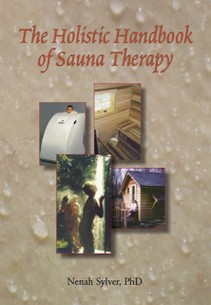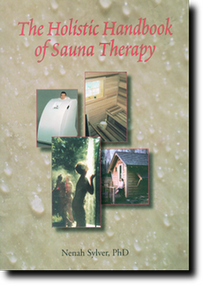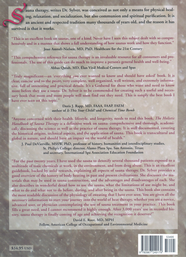Contents of Sauna Therapy Book
The Holistic Handbook
of Sauna Therapy
by Nenah Sylver, PhD
Softcover
375 pages

Have you ever wondered why sauna bathing is one of humankind's oldest therapies?
Our ancestors had a rather simple view of it: sweat, jump into snow or cold water, repeat. Sauna bathing was relaxing. It could be undertaken as a purification ritual. Practiced with family and friends, it was a time for socializing. But who would have thought that sweating was a complex affair? Or that saunas could play such an important role in remedying what ails us?
Today, with our heightened understanding of physiology and holistic healing, we finally have scientific proof that regular sauna therapy can indeed restore health through the elimination of many different kinds of toxins. Nenah Sylver, PhD, internationally published writer for 20 years—and author of the acclaimed Rife Handbook of Frequency Therapy with a Holistic Health Primer—thoroughly explores body heating in her newest work, The Holistic Handbook of Sauna Therapy. If you thought that saunas are frivolous or a luxury you can’t afford, you’re in for a welcome surprise.
Saunas have existed since the discovery of fire, their health benefits documented for as long as recorded history. Heating chambers have been built from clay, wood, animal skins, and even glass. They have been heated by everything from wood to heated rocks to hot sand. And they have ranged in size from crawl spaces in the ground to massive solariums.
This book bridges the wisdom of the ancients with current medical research and advances in electronic technology. We have come a long way from the carefully stoked fires of our ancestors. Modern saunas are built in every imaginable size, shape, and material. Innovative heat sources include far infrared electric heaters, which permit one to sweat at lower temperatures while utilizing the most healing frequencies on the electromagnetic spectrum.
Dr. Sylver has compiled a fascinating array of sources. The bibliography cites contemporary medical journal articles along with accounts that are centuries old but still relevant. There are many pages of easy-to-use tables. One section pinpoints what sauna style, heat source, and construction materials are best suited to particular needs. Another section identifies which symptoms and conditions respond well to sauna therapy, which require medical supervision, and which contraindicate the use of heat treatments altogether. (With proper supervision most people, regardless of their health issues, can benefit.) There is even an appendix on ozone.
Of special interest is a historical photo essay of different saunas, ranging from Dr. John Harvey Kellogg’s original electric light bath—invented in the 1900s after he saw a nurse use incandescent bulbs to eliminate her asthma—to modern sauna cabins complete with showers and rock-filled electric heaters. For the reader who wants a referral to a spa or clinic that uses heat therapy, this book has extensive listings (mostly domestic, and some international).
The Holistic Handbook of Sauna Therapy contains a detailed index. However, the chapters are already sensibly arranged to help you learn about sauna and apply its benefits to your life:
Chapter 1: The History of Saunas—Social and medical uses of heat therapy around the world from ancient times to the present, including sections on steam baths and hydrotherapy.
Chapter 2: How and Why We Sweat—The physiology of sweating, what heat therapy can and cannot do, dispelling myths about saunas.
Chapter 3: What We Sweat—The effects of harmful chemicals and pollutants; where they come from; and scientific studies on the elimination of heavy metals, pesticides, and other contaminants during sweating.
Chapter 4: The Three Types of Heat—Comparing far infrared, light steam, heavy steam, and conventional dry heat; understanding the electromagnetic spectrum, including its infrared and far infrared portions; dangers of most ELF fields; and how to apply heat transmission principles to your therapeutic needs and choice of sauna.
Chapter 5: Construction of the Sauna—The sauna building materials most compatible with your chosen heat source; and the sauna type best suited to your heat source, toxicity level, and spatial comfort.
Chapter 6: Who May Use the Sauna and Who Should Not—Medical conditions helped by sauna therapy, when it’s safe to use the sauna, when precautions are advised (and what kind), and when to seek supervision from a health care practitioner.
Chapter 7: How to Take a Sauna—What to do before, during and after a sauna session; how to recognize overheating and heatstroke; and care of the sauna.
Chapter 8: Detoxification Programs for Getting Well and Staying Well—The physiology and biochemistry of detoxification, how to support the liver, suggested nutrients during your detox program, and individual detox protocols that include sauna use from medical specialists across the United States.
Appendix A: A Brief Summary of Ozone—Myths about ozone dispelled, the properties of ozone and how it can heal, and the many applications of ozone (including ozone in sauna cabinets).
Appendix B: Resources—Sauna manufacturers, spa and health organizations, spa-related products, and spas and medical clinics (domestic and international) that use sauna and other heat treatments.
From a Review:The book is very user-friendly despite its scope and depth. Combining her obvious love of the natural sciences with a talent for presenting complex information in a readable and engaging style, Dr. Sylver explains concepts clearly enough for the layperson, yet with enough scientific documentation to satisfy the most exacting health care practitioner. She literally sweated over this book for three years—almost daily, she took a break from her writing with rejuvenating saunas. Her first-hand knowledge of this wonderful modality, plus her understanding of small details along with the big picture, make this one book you’ll want to read and reread many times.
If you have a health concern or know someone who is ill, if you are curious about how sweating eliminates toxins and the relationship of toxic overload to disease, or if you could use some tips on how to optimize your sauna experience, you will love this book. And if, after your appetite is whetted, you decide to buy your own sauna—or install one in your practice, if you’re a health care provider—you will find this book indispensable. After reading The Holistic Handbook of Sauna Therapy, your relationship to sweating will never be the same.
Publisher: Stone Ridge, New York
The Center for Frequency (2004)
ISBN Number: 0-9672491-7-1
Book size: 7" x 10"
Page Count: 360
Format: Softcover and eBook
eBook for Windows: 6.5 MB





